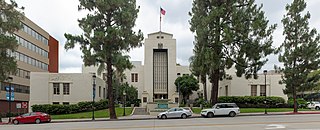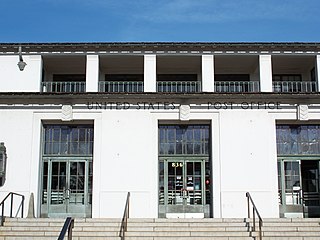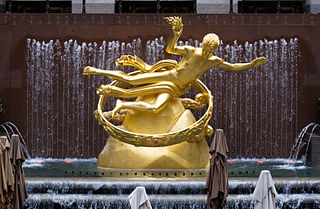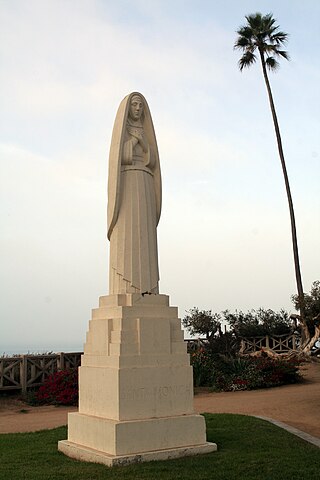
The Spanish Colonial Revival style is an architectural stylistic movement arising in the early 20th century based on the Spanish colonial architecture of the Spanish colonization of the Americas.

Miracle Mile is a neighborhood in the city of Los Angeles, California.

Streamline Moderne is an international style of Art Deco architecture and design that emerged in the 1930s. Inspired by aerodynamic design, it emphasized curving forms, long horizontal lines, and sometimes nautical elements. In industrial design, it was used in railroad locomotives, telephones, toasters, buses, appliances, and other devices to give the impression of sleekness and modernity.

The Eastern Columbia Building, also known as the Eastern Columbia Lofts, is a thirteen-story Art Deco building designed by Claud Beelman located at 849 S. Broadway in the Broadway Theater District of Downtown Los Angeles. It opened on September 12, 1930, after just nine months of construction. It was built at a cost of $1.25 million as the new headquarters and 39th store for the Eastern-Columbia Department Store, whose component Eastern and Columbia stores were founded by Adolph Sieroty and family. At the time of construction, the City of Los Angeles enforced a height limit of 150 feet (46 m), however the decorative clock tower was granted an exemption, allowing the clock a total height of 264 feet (80 m). J. V. McNeil Company was the general contractor.

Maya Revival is a modern architectural style popular in the Americas during the 1920s and 1930s that drew inspiration from the architecture and iconography of pre-Columbian Mesoamerican cultures.

Robert Stacy-Judd (1884–1975) was an English architect and author who designed theaters, hotels, and other commercial buildings in the Mayan Revival architecture Style in Great Britain and the United States. Stacy-Judd's synthesis of the style used Maya architecture, Aztec architecture, and Art Deco precedents as his influences.

The Pueblo Revival style or Santa Fe style is a regional architectural style of the Southwestern United States, which draws its inspiration from Santa Fe de Nuevo México's traditional Pueblo architecture, the Spanish missions, and Territorial Style. The style developed at the beginning of the 20th century and reached its greatest popularity in the 1920s and 1930s, though it is still commonly used for new buildings. Pueblo style architecture is most prevalent in the state of New Mexico; it is often blended with Territorial Revival architecture.

Downtown Santa Ana (DTSA), also called Downtown Orange County, is the city center of Santa Ana, the county seat of Orange County, California. It is the institutional center for the city of Santa Ana as well as Orange County, a retail and business hub.

Burbank City Hall is the site of the municipal government of Burbank, California, and is listed on the National Register of Historic Places.

Charmont Apartments is an historic five-story apartment building in Santa Monica, California which was built in 1928. Designed by architect Max Maltzman with elements of both the Mission Revival-Spanish Colonial Revival style and the Art Deco style, the Charmont was a luxurious high-rise when it was built. The blending of Spanish Colonial Revival and Art Deco elements was popular style in the 1920s and is sometimes known as "Med-Deco." The main entrance is located in a walled courtyard that features a two-tiered fountain with an intricate Moorish-patterned backsplash in polychrome tile.

The Beacon, known for many years as the Hotel Shangri-La, is a historic boutique hotel located at 1301 Ocean Avenue in Santa Monica, California. It is an example of Streamline Moderne architecture and Art Deco design.

Walker & Eisen (1919−1941) was an architectural partnership of architects Albert R. Walker and Percy A. Eisen in Los Angeles, California.

The U.S. Post Office in Santa Barbara, California is a combined post office-federal office building in Santa Barbara, California. The post office is a prominent example of Mission Revival-influenced Art Deco design and is a significant building in the historic core of Santa Barbara. It was designed by Pasadena architect Reginald Davis Johnson in the mid-1930s, and was completed in 1937. The building retains a high degree of architectural integrity, with minimal changes to the interior and no changes to the exterior, which retains its original landscaping.

Edgemar, located at 2415–2449 Main Street in Santa Monica, California, is a mixed-use shopping center designed by architect Frank Gehry that combines early 19th century warehouses, a 1940s Art Deco office building and new construction.

The Art Deco style, which originated in France just before World War I, had an important impact on architecture and design in the United States in the 1920s and 1930s. The most notable examples are the skyscrapers of New York City, including the Empire State Building, Chrysler Building, and Rockefeller Center. It combined modern aesthetics, fine craftsmanship, and expensive materials, and became the symbol of luxury and modernity. While rarely used in residences, it was frequently used for office buildings, government buildings, train stations, movie theaters, diners and department stores. It also was frequently used in furniture, and in the design of automobiles, ocean liners, and everyday objects such as toasters and radio sets.
Arthur E. Harvey (1884–1971) was an American architect. He designed many buildings in Los Angeles, California, including at least three on Wilshire Boulevard.

Santa Monica is an Art Deco sculpture by Eugene Morahan (1869–1949) installed in Santa Monica's Palisades Park, overlooking the Pacific Ocean in California.

The Georgian Hotel is a historic building in Santa Monica, California, in the United States. An eight story skyscraper designed in the Art Deco style, it opened as a hotel in 1933.


















